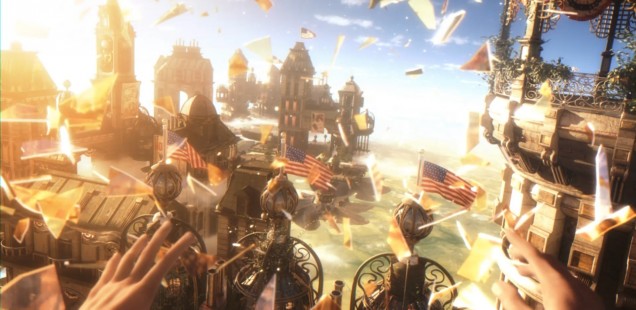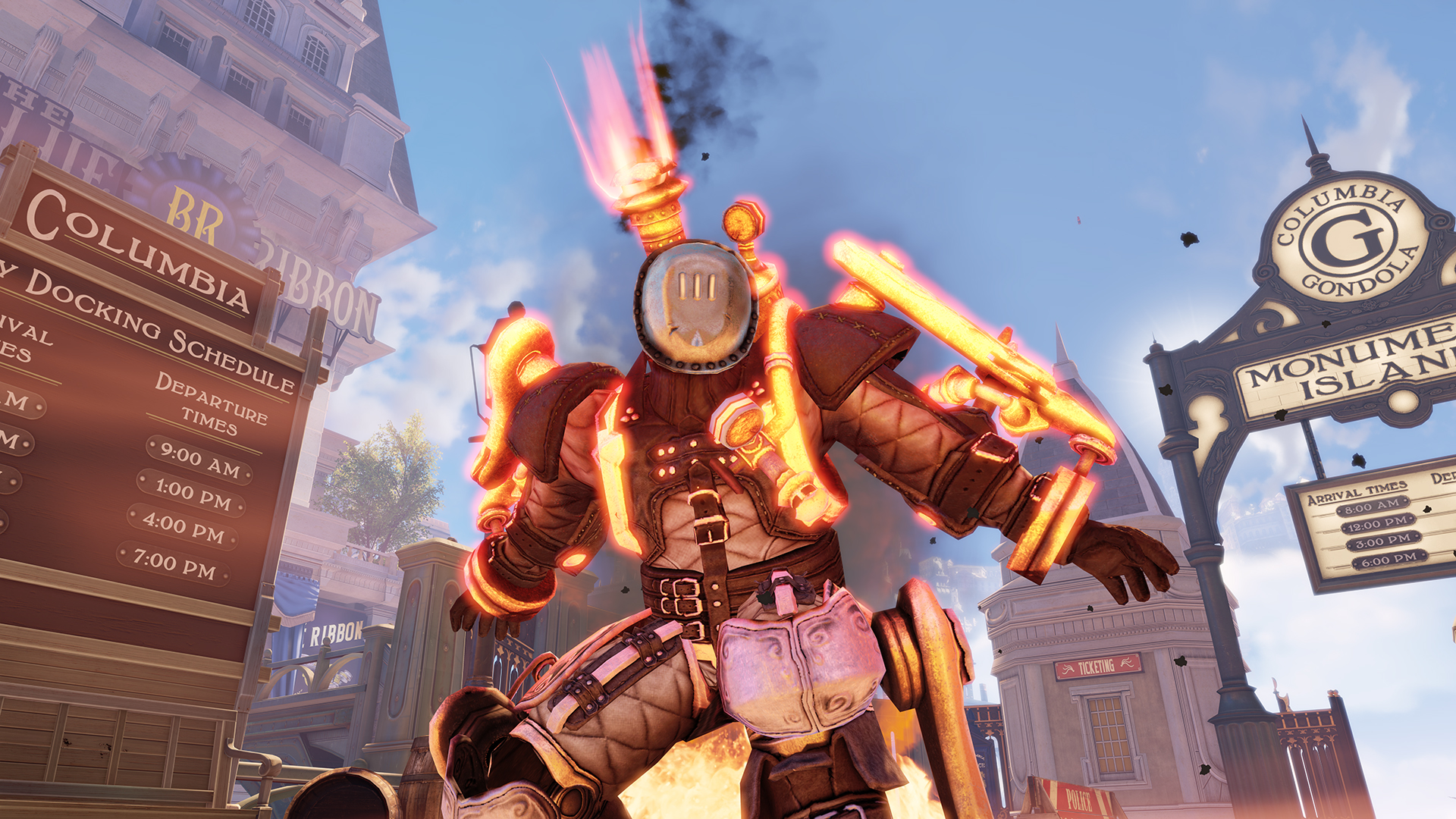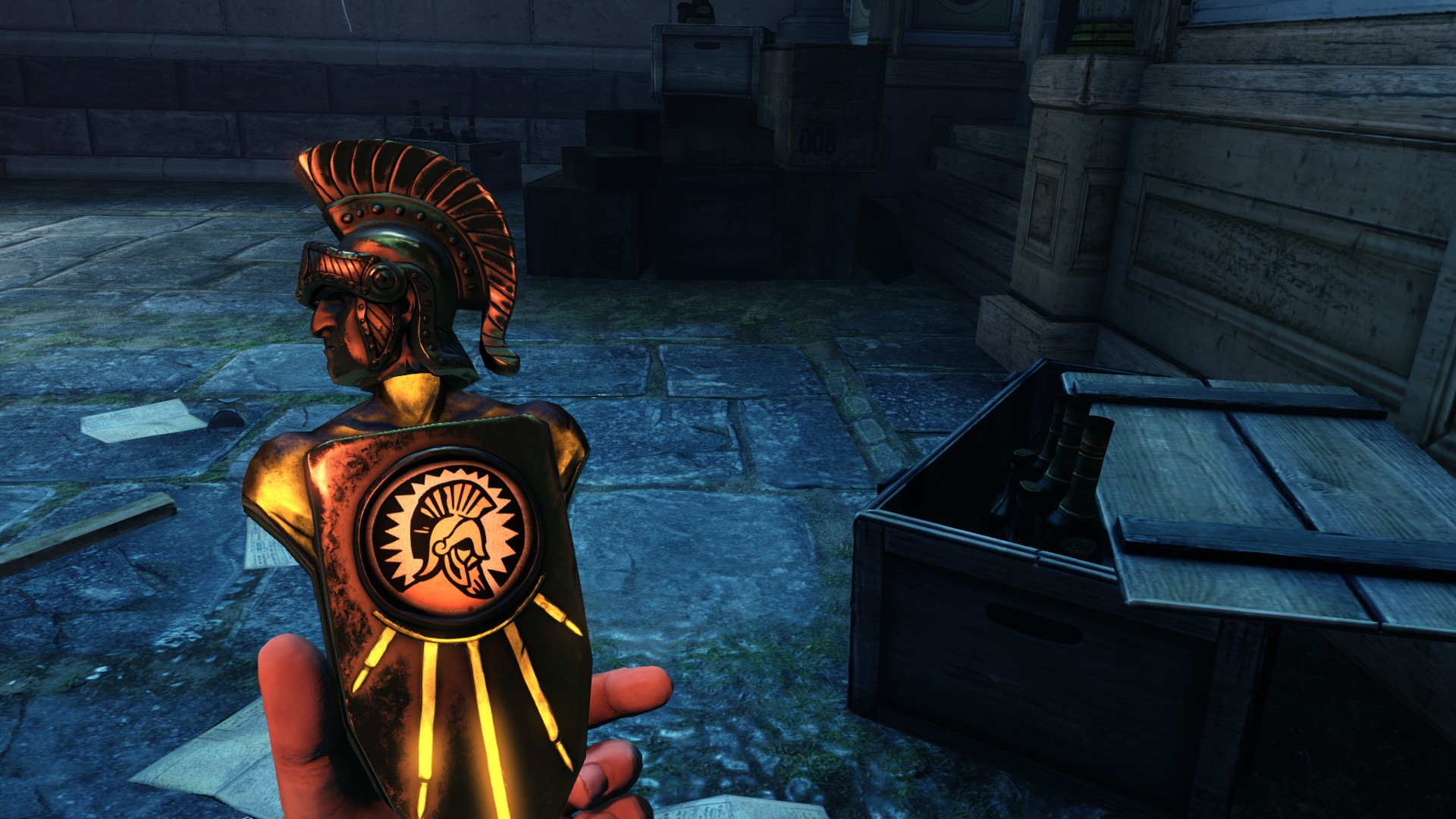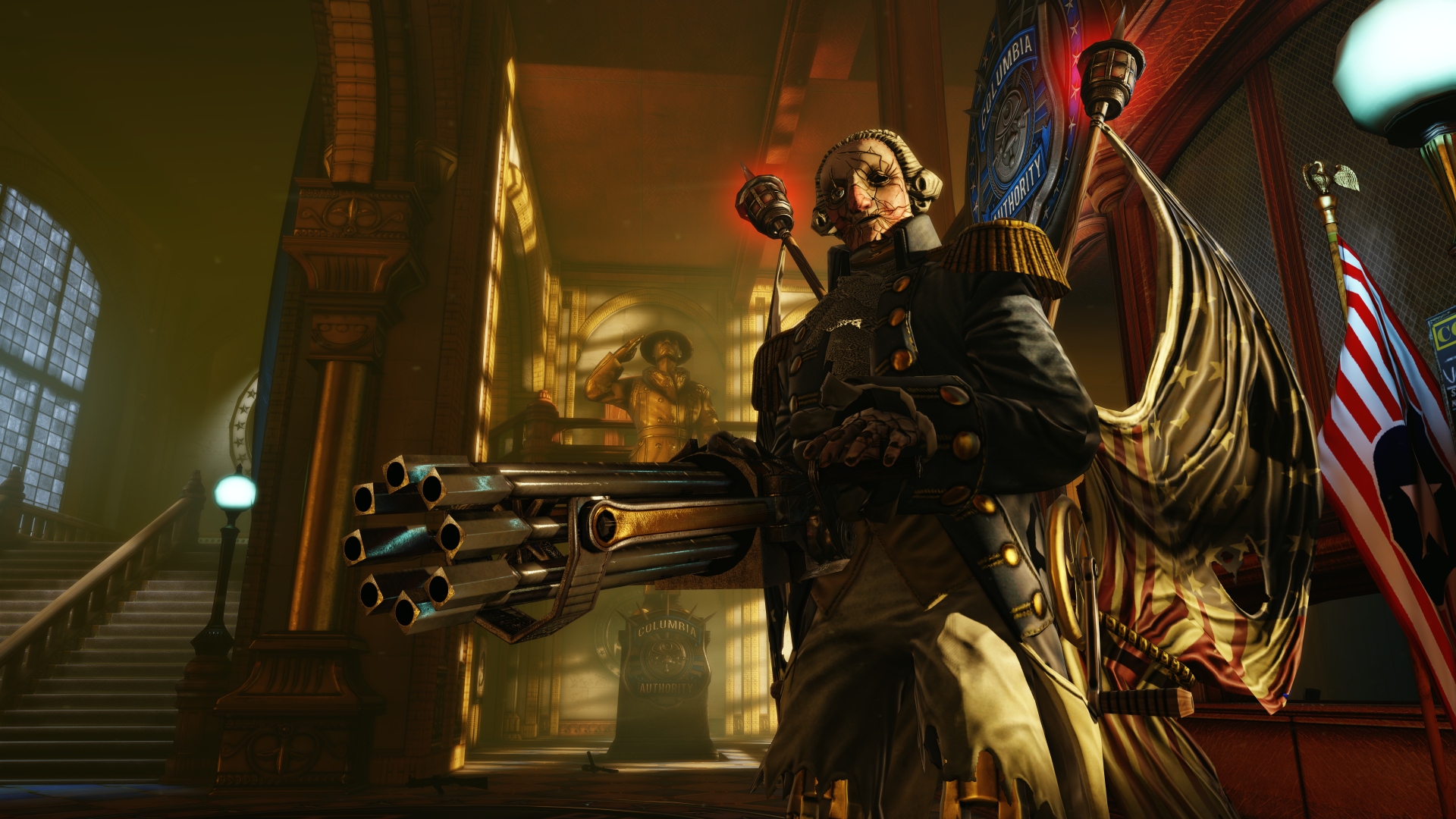
Breaking Bioshock
Andrew Walt explores what happens when you play a shooter without picking up a gun.
Few things are as fragile as a video game. One wayward twitch of the camera, one mistimed sting of the sound design, one errant input of the player can irrevocably shatter the painstakingly wrought illusion of a beautiful world. It’s enough to make one wonder what’s more miraculous: that these experiences can be earnestly believed, or that they can even be effectively designed at all.
It’s an outrageously tall order, not just to present a fiction to another and expect it to be enthusiastically accepted with conviction, but to allow it to be inhabited and potentially ruined by the unanticipated whims of an audience. This tension between designers attempting to intuit interaction and players charting their own course through an experience is only becoming more and more pronounced as video games mature. Something as simple as a film’s score suddenly stinging a jump scare in horror is a remarkably fiddly instance to translate to a video game. Dare you force and lock that perspective for the integrity of the gimmick and betray interactivity, or do you trust your design and the player’s focus in the fiction not to be wandering from the deliberately scripted moment?
Released in March of this year, Bioshock Infinite seems to have demonstrated this tension between linearity of design and freedom of expression quite unlike any game before it, at least as regards the cripplingly unstable big-budget/mass-appeal homogenized first-person shooter space. Laments of excessive violence and the sudden appearance of ludonarrative dissonance in everyone’s vocabulary are manifestations of how deeply flawed the core design of Bioshock Infinite is. But to the game’s credit, and almost certainly to the knowledge of its developers over the course of its creation, “one does not undertake an experiment knowing one has failed.”
While I personally consider it unfair to measure a videogame against any particular standard instead of considering its merits in isolation, it is in the case of Bioshock Infinite worth taking a brief moment to reflect on 2007’s Bioshock. This is not to compare Rapture and Columbia, plasmids and vigors, or Andrew Ryan and Comstock, but rather to examine their balance of player expression in linear design.
There is a defining moment in both games when you are first introduced to the city. As you ride the bathysphere into Rapture, you are presented with a narrated short film, sweeping vistas of an underwater city and some brief text meant to provide a philosophical underpinning. As you ride the rocket into Columbia, you’re presented with similarly euphoric sensory overload. The difference? Your avatar in the bathysphere can stare at the floor or otherwise look away and be completely disinterested, whereas Bioshock Infinite is so concerned with maintaining the integrity of its illusions that it literally binds you to a chair and forces you to look through its window, give or take a modicum of camera freedom.
While it may seem like a minor detail, this initial restriction of freedom in Bioshock Infinite characterizes the majority of a player’s experience throughout the game. Take the elevator ride up to confronting Daisy Fitzroy in Fink’s Factory, for example. Press a button to activate a locked animation of Booker pressing a button. Booker and Elizabeth then recite scripted dialogue as your heads-up display is stripped away, leaving you with only the ability to pace freely around the elevator. The intercom rings, halting everything until you answer it. Daisy Fitzroy picks up as your perspective is effectively locked into staring at Elizabeth until she finishes her lines (you can jerk the camera away, but it always comes to rest at a specific image). The elevator resumes and you soon reach yet another gunfight. These are mixed degrees of agency in service of a glorified cutscene.
 Just as how elevators and intercoms forcibly and inconsistently limit interaction with Bioshock Infinite‘s narrative, locked doors create similar issues for gameplay. As happens annoyingly often throughout the later phases of the game, you must get Elizabeth to pick the locks of doors barring your progress. However because gunfights tend to occur in front of locked doors, Elizabeth won’t be able to concentrate and pick the lock until you’ve cleared the area of enemies. This soon becomes a frustratingly artificial and lazy mechanism to have players engage with the genre’s well-worn “shooting people in the face” gameplay. Ironically, the claustrophobic corridors and cramped rooms of Bioshock feel far more free than Bioshock Infinite‘s firmly structured and demarcated stop’n’go arenas.
Just as how elevators and intercoms forcibly and inconsistently limit interaction with Bioshock Infinite‘s narrative, locked doors create similar issues for gameplay. As happens annoyingly often throughout the later phases of the game, you must get Elizabeth to pick the locks of doors barring your progress. However because gunfights tend to occur in front of locked doors, Elizabeth won’t be able to concentrate and pick the lock until you’ve cleared the area of enemies. This soon becomes a frustratingly artificial and lazy mechanism to have players engage with the genre’s well-worn “shooting people in the face” gameplay. Ironically, the claustrophobic corridors and cramped rooms of Bioshock feel far more free than Bioshock Infinite‘s firmly structured and demarcated stop’n’go arenas.
The result of all this constriction is a crushing sense of linearity. While not necessarily a bad thing in and of itself, the extent of its arbitrarily scripted design betrays a certain freedom of expression, characteristic to what might be considered the Bioshock experience. You move from one shootout to the next, forever leaving behind massive chunks of the game. Vigors are introduced at specific moments for specific applications. Upgrades grant efficiency and economy, and nothing else. Bioshock Infinite, such as it’s designed, encourages only one direction – forward – and only one interaction – shooting – all in service of a toothless theme.
But what happens if you try to seize the freedom to express your preferred, albeit antithetical, style of play from a series of mechanics and systems rigidly designed to provide a specific experience? What happens if you reject Bioshock Infinite’s incessant forward-march/trigger-twitch gameplay and focus on charting a different course? What happens if you forgo violence altogether?
Admittedly, changing the way one interacts with a video game is not a novel idea. People ask themselves hypotheticals about their favourite games all the time. How quickly can I complete Portal? What’s the fewest number of power-ups I can use to beat Super Metroid? Can I beat Resident Evil 4 using only hand grenades? I asked myself a similar question: Can you get through Bioshock Infinite without dealing any direct damage?
 As it turns out: yes, yes you can.
As it turns out: yes, yes you can.
Disregarding scripted events beyond the control of the player, it is possible to complete Bioshock Infinite without firing a single weapon or directly killing anyone. Make no mistake, a staggeringly large number of your fellow man will still die over the course of such a playthrough – Bioshock Infinite’s themes demand it, after all – but it won’t be directly by Booker’s hand, so long as you’re the one in control of it. The key is to coax enemies into dealing with themselves via unusual methods; gameplay which is simultaneously mechanically supported and narratively subversive.
For the purposes of such a playthrough, direct damage consists of attacks squarely targeted against enemies with all firearms and damage dealing vigors as well as melee manoeuvres. Indirect damage, which must be exploited to succeed (violent as it still might be), includes use of the Possession vigor on enemy units, vigor traps, tear manipulation and passive abilities from certain pieces of gear (equipping pants with a percentage chance to cause burn damage to melee attackers, for example).
With these parameters in mind, the experience of Bioshock Infinite radically changes almost immediately. The game’s very first conflict with the policemen at the raffle turned into a frenzied dash to lose my pursuers instead of dispatching them, a dynamic that became my first reaction whenever confronted with violence. In fact it was my initial hope that most of the combat in Bioshock Infinite could simply be avoided by pressing on and ignoring it.
However, fleeing is not always possible. There are many times when areas will lock down and progress will be inhibited until the threats have been dispatched, whether for gameplay, for narrative, or for asinine reasons: dealing with the first Fireman and the first Crow to earn their respective vigors, dispatching Slate’s men to give them a “soldier’s death” in the Hall of Heroes and contrived locked doors respectively.
How, then, do you deal with these situations? For the first Fireman, possess a nearby turret to kill him for you. For the first Crow, lay firebomb traps and bait him into stepping on them. In fact, vigor traps are relied upon to an uncomfortably tedious degree throughout this type of playthrough. While perhaps unconventional, it doesn’t seem terribly inventive. We’re not exactly rescuing the president’s daughter from iron bindings in a Spanish castle by strategically tossing grenades at her, that’s for sure.
While Bioshock Infinite’s heavy hitter enemy types are content to charge at you with reckless abandon, thereby making it easy to lure them into vigor traps, standard groups of gun wielding humans present a more fascinating challenge. Because their AI actively makes attempts to flank the player and sidestep danger, baiting them into traps is actually a less than ideal way to handle them. I first noticed this when I was trapped in a skirmish in Battleship Bay: The last enemy in the room wasn’t keen to walk into my firebomb trap, so after quite some time pacing and repositioning myself, I became more direct and kept walking into him. This meant suffering myriad bullet wounds and occasional melee strikes, but eventually I did in fact cause him to step backward into the trap, causing the gates to open and more enemies to flood in.
It was at this stage that I realized just how tedious this experiment would turn out to be. It was frustrating to note how narrow my options for expressing myself in a pacifist (or at least indirectly violent) way were. In Bioshock, I could use the Telekinesis plasmid to hold explosive containers in front of splicers for them to attack until the explosions killed them. I could buy and trade out passive tonics at a whim to deal damaging elemental novas to enemies who attacked me with crowbars or the butts of their guns. I could permanently hack flying security turrets to follow me, I could set boobytraps with electric crossbow bolts and proximity mines, I could even conquer Fontaine by letting him punch me in the face until he died of spike damage. Was the extent of Bioshock Infinite’s support for indirect damage really just vigor traps and spamming Possession? Or perhaps I simply wouldn’t mind so much if I wasn’t forced into so many inescapable combat scenarios.
To Bioshock Infinite’s credit, there are other ways to deal indirect damage, but still fewer than in Bioshock. One of its unique mechanics is tears, which allow you to call on Elizabeth to summon friendly turrets and heavy hitters from parallel universes. If you’re feeling nostalgic, there are even certain occasions where you can summon leaky fire hydrants to zap ‘em and whack ‘em, just as Atlas advised back in Rapture (only without the whacking, in my case). The only other unique method available is using the upgraded Possession vigor on standard human enemies, which would otherwise be reminiscent of the Enrage plasmid, if the target committed suicide when it wore off. I would also be remiss to overlook how passive abilities do in fact reappear as swappable items of clothing, but because this mechanic is randomized, discrete and not nearly as customizable as Bioshock’s tonics, I feel it arbitrarily limits player expression. I could freely choose the tonics I wanted in Bioshock, whereas Bioshock Infinite decides what gear it wants to give me from one instance to the next.
Tedium aside, I was succeeding. Even my first Handyman fight proved surprisingly simple thanks to a nearby tesla coil tear that essentially killed him for me. The only genuine difficulty was Lady Comstock’s ghost, whose erratic movement made it difficult both for possessed enemies with launchers and my own vigor traps to hit. Eventually I resorted to charging Return to Sender (which shields incoming enemy fire and allows it to be harnessed for yet another variety of vigor trap) and placing the charge directly underneath Lady Comstock whenever she would rise into the air to summon more enemies. It certainly did the trick well enough, despite the tactic just being more of the same.
In fact, the most fascinating event of this playthrough was Comstock House, thanks in no small part to the game tossing me my first piece of passively damaging gear after my second Handyman fight in Emporia. Because the lunatics here only dealt melee damage and rushed in swarms, I was able to handle my adversaries by just letting them attack me until the passive burn damage effect of my gear cleared the room. Amusingly, what once had been a forced stealth section now became a bold sprint out in the open, ably trounced by my magic pants.
After Comstock House, the experiment was, for all intents and purposes, over. What little remained of the game was easily accomplished with Possession, Return to Sender traps, the occasional turret from a tear and fleeing. Even the game’s third Handyman within Comstock’s flagship turned out to be entirely optional since I could just sprint past it. There were no new challenges and no new indirect methods. And for all this unorthodox gameplay, my only reward was a tranquil moment on the deck of Comstock’s flagship under the night sky, just after the final firefight and just before Bioshock Infinite’s falling action. The only difference between my no-direct damage run and any other playthrough? There wasn’t a gun bobbing up and down at the bottom of my screen. I hadn’t picked up a single weapon.
Not that I was expecting Bioshock Infinite to congratulate me on my pacifism. While its gameplay may entertain more notions of creativity than the average linear shooter, it’s nevertheless far more resistant than welcoming. I may have changed my experience with the game by opting to pursue a less puerile course, but the game certainly made no accommodations for my decisions. Truth be told, its only appreciable respect for my experiment was that it never once forced me to hold a gun (although Fink did once offer me a hand cannon). And while this may have been enough for any other game, it is perhaps Bioshock Infinite’s most damning flaw.
It’s laudable when an audience is able to identify a theme in a piece of art, but fatal when a piece of art forces its themes upon an audience. In this regard, Bioshock Infinite doesn’t suggest so much as it shouts. “You, as a player manipulating an avatar, are a violent creature committing outrageous violence and I, as a video game communicating my interests, will exploit that fact for thematic resonance.” We see this whenever Comstock hints at Booker’s violent nature and specifically when Elizabeth calls Booker a “monster” for his actions at Battleship Bay. Indeed these judgments will hold true for the vast majority of romps through Columbia, but mine is an exception that is simultaneously supported and subversive. And yet Bioshock Infinite, via Comstock, Elizabeth and its tyrannically authored script, will still pass the same invalid verdict.
 Perhaps I should just be content with the humorous nonsense of a terrified and trembling Elizabeth saying “you killed those people” when I haven’t actually killed anyone. Perhaps I should just be relieved by how I don’t magically produce a nonexistent gun when given the option to draw a weapon at the Battleship Bay ticket office. Perhaps I should just be happy that I broke a game by undermining its narrative with a subversive approach. But my experimental and completely antithetical gameplay on a second playthrough still doesn’t remedy the jarring ludonarrative discomfort of the first. All it really does is provide a bit of catharsis.
Perhaps I should just be content with the humorous nonsense of a terrified and trembling Elizabeth saying “you killed those people” when I haven’t actually killed anyone. Perhaps I should just be relieved by how I don’t magically produce a nonexistent gun when given the option to draw a weapon at the Battleship Bay ticket office. Perhaps I should just be happy that I broke a game by undermining its narrative with a subversive approach. But my experimental and completely antithetical gameplay on a second playthrough still doesn’t remedy the jarring ludonarrative discomfort of the first. All it really does is provide a bit of catharsis.
The issue, as I see it, is less that Bioshock Infinite is a violent game and more that it dares presuppose and comment on its theme of violence as if they must have been consistently experienced. And while this is almost undeniably true given the sheer volume of hostile encounters forced upon its players, it need not necessarily be the case. Both the general discussion surrounding the game since its release and my own pacifist playthrough reflect that.
Bioshock Infinite’s design confines players into gameplay that places the game’s interests in theme above their own interest in expression. It locks you in rooms deliberately designed to turn you into the monster its narrative demands, all for the sake of a meta-trick that regards the player as nothing more than a trigger finger. This may justify its violent themes, but it doesn’t excuse its gross excesses and it certainly doesn’t make them any more palatable. Regardless of whether you kill everyone or kill no one, people die and you’re still a monster. But just as Booker himself says to Elizabeth when confronted with that very same fact, “What did you think was going to happen?”
Andrew Walt is a lapsed amateur journalist and graduate student of Classics at McMaster University in Canada.

